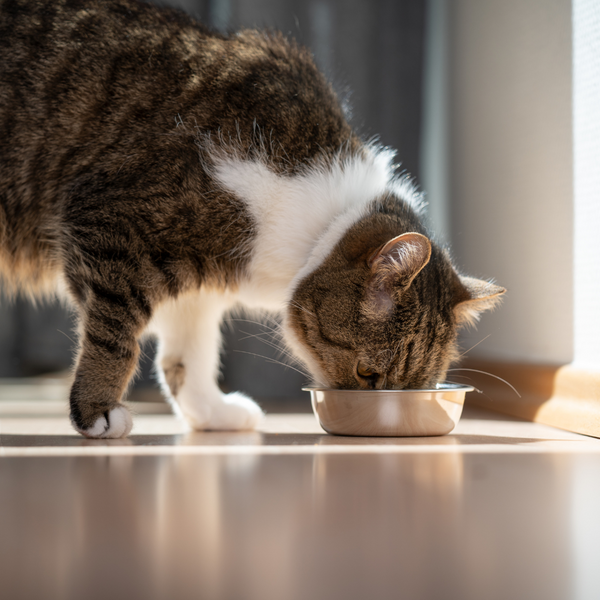
Food Allergies in Pets - What Are The Signs and Symptoms?
Just like us humans, pets can also suffer from food allergies. Food allergies mean an immune-mediated reaction to an ingredient found in your pet's food. The most common ingredients in dog or cat food that can lead to food allergy are proteins.
Clinical signs usually involve persistent itching and scratching, foul body or ears odor, spots or red areas on the skin, and matted fur. In severe and rare cases, food allergy can lead to anaphylactic shock.
There is also the term “food intolerance”. It is best to differentiate between food allergy and food intolerance, even if sometimes the clinical signs are similar. If in food allergies, your pet's immune system reacts to an ingredient in their food, in food intolerances, your pet’s body is unable to properly digest an ingredient.
The treatment of food allergies is as simple as possible: avoid the allergen.
How Do You Know That Your Pet Has a Food Allergy?
Food allergies are the most common pet allergies. These allergies are often manifested through skin problems and rarely through digestive problems. Because pets cannot tell us that they have a problem or that something is wrong with their bodies, it is best not to ignore the early clinical signs and not to wait until obvious symptoms appear. At this stage, pets are already suffering.
Pets usually groom and scratch their bodies, which is completely normal for them. However, when the itching does not go away or your pet overgrooms or scratches non-stop and keeps you awake at night, it is important to take them to the vet because they probably have a health problem.
Several signs that suggest your pet may have an allergy (not necessarily a food allergy) include:
- Chewing and licking their rears and paws (especially dogs)
- Scratching – it can vary in intensity and it is present all year round (in seasonal allergies, pets usually itch and scratch during spring and summer)
- Constant anal itching of high intensity – is considered to be a characteristic symptom of food allergies.
- Rubbing their face against the floor, couch, bed, etc. (especially dogs)
- Hair loss
- Repeated skin infections
- Recurrent ear infections – there are situations where these ear infections are the only clinical manifestation of food allergies.
- Smelly skin due to yeast infection
- Brown stains in white or light-colored fur pets – these stains are saliva stains (porphyrin staining) from repeated grooming of the area.
- Skin rash or red and painful skin – the most affected areas are: chin, face, ears, legs, belly, groin area, and armpits.
- Scaly skin
- Red, inflamed, itchy ears
- Matted fur
- Vomiting, diarrhea or soft stools (up to 20% of cases)
Less common symptoms of food allergies can be:
- Nasal secretions and watery eyes
- Respiratory problems
- Seizures
- Urinary tract infections
- Weight loss
In food allergies, it is best to take into account when and how you changed your pet's food. Your vet will definitely ask you this. For example, if you recently changed your pet’s diet and the scratching and overgrooming occurred, they could have an immune reaction to one of the ingredients. However, pets can become allergic to their diets even if they have been consuming them for some time. This happens because the immune system needs time to develop antibodies to an ingredient.
What Exactly Causes Food Allergies in Pets?
Food allergies can occur at any age, but they are most frequently diagnosed in dogs aged between two and ten years, and in cats between two and six years of age.
Pets can be allergic to any ingredient found in their food, even if they have always consumed it. However, some ingredients may have a higher allergenic potential.
In the case of dogs, the ingredients with high allergenic potential are:
- Beef
- Chicken
- Lamb
- Dairy
- Wheat gluten
Ingredients with low allergenic potential include:
- Soy
- Corn
- Eggs
- Fish
- Pork
- Rice
Regarding cats, the most common ingredients with high allergenic potential are:
- Beef
- Fish
- Chicken
- Dairy
Ingredients with low allergenic potential are:
- Dairy
- Wheat
- Barley
- Corn
- Lamb
- Rabbit
- Eggs
Unfortunately, many of the ingredients listed above are commonly found in pet diets. Therefore, if your dog or cat eats something they are allergic to, their immune system will overreact and the clinical signs will become visible. What you can do is take your pet to the vet as soon as the clinical signs occur.
Pet treats can also cause food allergies and may contain different ingredients from their normal food. Food additives and preservatives are not considered to be frequent causes of food allergies in pets.
Are Certain Breeds of Dogs or Cats More Prone to Food Allergies?
As far as dogs are concerned, there are actually no breeds that are more prone to food allergies than others. However, it seems that these allergies are more common in breeds prone to atopic dermatitis (a condition that causes intense itching), such as:
- Shar Pei
- Labrador Retriever
- Golden Retriever
- Dalmatian
- Dachshund
- English Springer Spaniel
- American Cocker Spaniel
- Collie
- Poodles
- German Shepherd
- French bulldog
- English bulldog
- Pug
- Boxer
- Pitbull
Regarding cats, it seems that Siamese, Siamese crosses, and Devon Rex are more susceptible to food allergies than other cat breeds.
How Are Food Allergies Diagnosed in Pets?
The clinical signs mentioned above are not specific only to food allergies, they may also appear in other skin conditions, such as:
- Atopic dermatitis
- Malassezia infections
- Bacterial infections
- Parasitic infections
- Allergic dermatitis to flea bites
The most accurate way to diagnose food allergies in pets is the so-called elimination diet trial. Your veterinarian will recommend a hypoallergenic diet that contains ingredients to which your dog or cat will not have any allergic reaction. Apart from water, you will not give your pet anything else (not even treats because these can also cause food allergies). If your dog or cat shows signs of relapse, they were likely allergic to an ingredient in their regular diet.
Although there are blood and saliva tests available to diagnose food allergies in pets, they are not reliable. Skin tests also proved to be ineffective.
To confirm the diagnosis, your vet can reintroduce your pet's regular food into their diet. If the clinical signs recur in approximately two weeks, then the diagnosis of food allergy is confirmed. If your pet consumes more than one type of food, then these will be reintroduced into their diet gradually.
How to Treat Food Allergies in Pets
Treating food allergies in pets is usually easy. The resolution of clinical signs and symptoms should occur when all food allergens are eliminated from your dog’s or cat’s diet. Remember that food allergies tend to last the whole life of your furry friend, so these food exclusions must be permanent.
In addition, if you have several pets, it is advisable to feed them separately to avoid accidents (e.g., your dog is eating from your cat's bowl and so on). If you have a dog that likes to eat everything they find on the ground, it is advisable to monitor them closely when you take them for a walk to prevent accidental situations.
In more severe cases, secondary skin infections (bacterial or fungal) may occur. In these cases, the vet can prescribe antibiotics or antifungals to treat the infections. Moreover, antihistamine drugs can also be recommended to reduce itching.

Post a Comment!